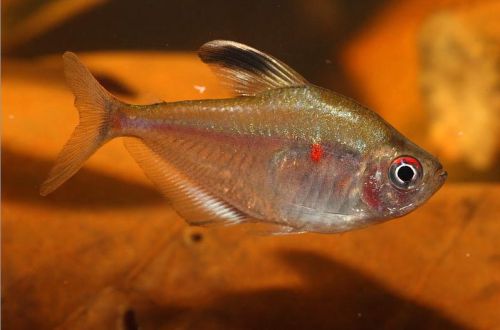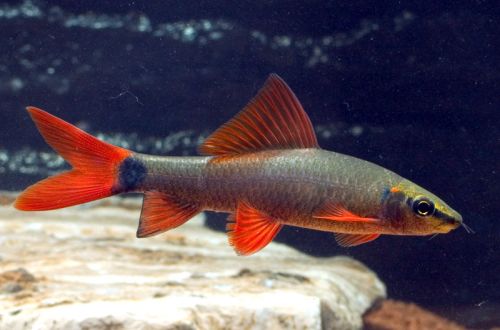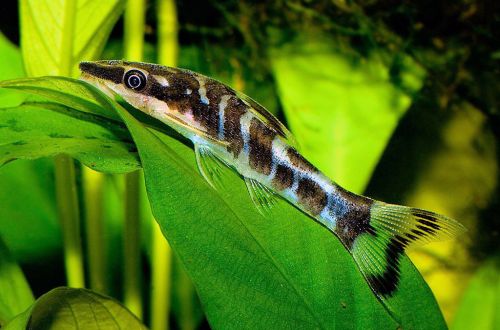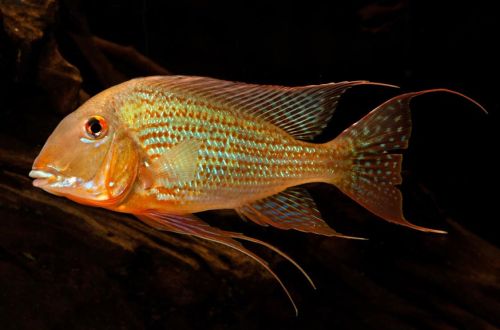
Minor Rubostigma
Sokolof’s tetra or Lesser Rubostigma, scientific name Hyphessobrycon socolofi, belongs to the Characidae family (Characinidae). Named after the largest American seller of aquarium fish, Ross Sokoloff (1925–1999). They are easy to keep and breed, compatible with other freshwater species and make a great addition to both hobby and professional aquariums.

Contents
Habitat
It comes from South America from the basin of the Rio Negro River – the largest left tributary of the Amazon (Brazil). They inhabit regions with a slow current, backwaters with a large number of snags, aquatic and overhanging vegetation. In its natural habitat, the water has a rich brown hue due to the abundance of dissolved tannins formed as a result of the decomposition of plant organic matter.
Brief information:
- The volume of the aquarium – from 80 liters.
- Temperature – 20-28°C
- Value pH — 4.0–7.5
- Water hardness – 1–10 dGH
- Substrate type – any dark
- Lighting – subdued
- Brackish water – no
- Water movement is weak
- The size of the fish is up to 5 cm.
- Feeding – any food of suitable size
- Temperament – peaceful
- Keeping in a group of 8-10 individuals
Description
Outwardly, it is almost identical to Ornatus red-dotted, only slightly smaller. Adults reach a length of up to 5 cm. Males, unlike females, are larger and have elongated dorsal, anal and ventral fins. The color of the body is silvery with pink edging of the fins. A characteristic feature of the species is the presence of two red dots. The first, more noticeable, is located in the middle of the body, the second, less noticeable, at the base of the tail.
Food
An omnivorous species, so it is easy to feed it in a home aquarium. Accepts most popular suitable size aquarium fish foods. The daily diet can consist exclusively of dry food in the form of flakes, granules. Live or frozen brine shrimp, daphnia, small bloodworms, etc. will not be superfluous.
Maintenance and care, arrangement of the aquarium
The optimal aquarium size for a group of 8-10 fish starts at 80 liters. The decoration is arbitrary, but it is preferable to recreate conditions reminiscent of the natural habitat using various driftwood, live or artificial plants. A dark substrate and subdued lighting will emphasize the silvery coloration of the fish.
Experienced aquarists additionally use the leaves of some trees to give the water a chemical composition similar to the composition in natural reservoirs in the habitats of this species of fish. For example, adding a layer of oak or Indian almond leaves will eventually color the water in a characteristic brown color and saturate it with tannins, in particular tannins. Leaves are renewed every one to two weeks. Read more in the article “Which tree leaves can be added to the aquarium”.
Like many other fish, Lesser Rubostigma needs clean water with suitable hydrochemical values and temperatures. Accumulation of organic waste and increase to dangerous concentrations of products of the nitrogen cycle (ammonia, nitrites, nitrates) should not be allowed. To do this, the aquarium must be equipped with all the necessary equipment, at least a filter and a heater, as well as mandatory maintenance procedures. The latter include: weekly replacement of part of the water with fresh water, cleaning the soil and design elements, checking / testing water, etc.
Behavior and Compatibility
In nature, Sokolof’s Tetras form large aggregations of about 100 or more individuals. In aquariums, it is also recommended to stay in a flock or small group of at least 8-10 fish. Friendly to other species, perfectly compatible with non-aggressive and comparable size fish.
Breeding / breeding
With the onset of the mating season, the fish spawn among the thickets of plants. Eggs can be fertilized by several males at once. There is no parental care for the offspring, so the clutch is in danger of being eaten. If breeding is planned, then protecting the eggs, they will need to be moved to a separate tank with identical water conditions, where in the future the fry will live until they become large enough.
Fish diseases
Diseases inherent in this particular species of fish were not noted. When kept in suitable conditions (high water quality, balanced diet, non-conflict neighbors, etc.), health problems are not observed. The most common cause of disease is the deterioration of conditions leading to immune suppression, which makes the fish susceptible to infections that are invariably present in the surrounding area. When the first signs of an illness are detected (lethargy, exhaustion, refusal of food, lowered fins, etc.), it is necessary to immediately check the main parameters of the water. Often, the restoration of acceptable living conditions contributes to self-healing, but if the fish is too weak or has received obvious damage, medical treatment will be required. For more information on symptoms and treatments, see the Aquarium Fish Diseases section.





